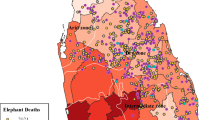Abstract
Ecotourism aims to deliver the philosophy of sustainable development through environmental conservation as well as socio-economic development. Areas with rich biodiversity and scenic beauty, like the Indian Himalayan region, have been one of the major destination centers for nature lovers from historical time. In view of conserving the rich biodiversity and natural heritage of the Himalayan region 92 protected areas have been set aside, of these Nanda Devi Biosphere Reserve (NDBR) is a well known world heritage site. Over a period of time establishing NDBR has invited conflicts between the local people and reserve authorities on the management approaches and utilization criteria of the natural resources, especially banning the traditional bio-resource collection rights of local community, expeditions, trekking, and other anthropogenic activities in the core zones. The present study aims to understand and analyze the various people - park conflicts, and also to suggest ways to mitigate such conflicts in view of biodiversity conservation and improvement of economic status of local people by promoting ecotourism. With this view the study further discusses the various aspects of ecotourism, its pros and cons, and the avenues of developing appropriate strategies for promotion of ecotourism in buffer zone areas of NDBR.
Similar content being viewed by others
References
Bornemeier J, Victor M, Durst PB (1997) Ecotourism for forest conservation and community development, Proceedings of an International Seminar, held in Chiang Mai, Thailand, 28–31 Janurary 1997. FAO/RAP Publication.
Coccossis H, Parpairis A (2000) Tourism and the environment: some observations on the concept of carrying capacity, (Briassoulis, H. and Straaten, J. eds.), in: Tourism and the environment: regional, economic, cultural and political issues, Kluwer Academic Publishers, Dortrect, pp 91–106.
Farooquee NA, Majila BS, Kala CP (2004) Indigenous knowledge systems and sustainable management of natural resources in a high altitude society in Kumaun Himalaya, India. Journal of Human Ecology 16(1): 33–42.
Gartner WC (1996) Tourism Development: Principles, Processes, and Policies. Van Nostrand Reinhold, New York.
Grossberg R, Treves A, Treves-Naughton L (2003) The incidental ecotourists: measuring visitor impacts on endangered howler monkeys at Belizean archaeological site. Environmental Conservation 30(1): 40–51.
Haroon AI (2000) Role of communities in ecotourism. Ecotourism Society of Pakistan, Pakistan. http://www.mtnforum.org/resources/library/haroa00a.htm
Heredge M (2003) Strategic development planning for sustainable tourism development in upper Mustang, Nepal. M.Sc. Dissertation submitted to Birkbeck University, London. pp 27
Hook B (1992) Black looks: race and representation. South East Press, Bosta, MM pp 28
Kala CP (1998) Ecology and conservation of alpine meadows in the Valley of Flowers National Park, Garhwal Himalaya. Ph.D. Thesis, Forest Research Institute, Dehradun, India. pp 180
Kala CP (2002) Indigenous knowledge of Bhotiya tribal community on wool dyeing and its present status in the Garhwal Himalaya, India. Current Science 83(7): 814–817.
Kala CP (2004a) The Valley of Flowers: Myth and Reality. International Book Distributors, Dehradun, India. pp 215
Kala CP (2004b) Pastoralism, plant conservation, and conflicts on proliferation of Himalayan Knotweed in high altitude protected areas of the Western Himalaya, India. Biodiversity and Conservation 13(5): 985–995.
Price M (1987) Tourism and forestry in the Swiss Alps: parasitism or symbiosis? Mountain Research and Development 7(1): 1–12.
Negi CS, Maikhuri RK (2002) Nanda Devi Biosphere Reserve — pro-poor tourism — and option. The Botanica 52: 101–111.
Nepal SK (2000) Tourism in protected areas: the Nepalese Himalaya. Annals of Tourism Research 27(3): 661–681.
Nothiger C, Elsasser H (2004) Natural hazards and tourism: new findings on the European Alps. Mountain Research and Development 24(1): 24–27.
Maikhuri RK, Nautiyal S, Rao KS, Chandrashekhar K, Gavali R, Saxena KG 2000a. Analysis of resolution of protected area people conflicts in Nanda Devi Biosphere Reserve, India. Environmental Conservation 27: 43–53.
Maikhuri RK, Rana U, Rao KS, Nautiyal S, Saxena KG (2000b) Promoting ecotourism in the buffer zone areas of Nanda Devi Biosphere Reserve: an option to resolve people-policy conflicts. International Journal of Sustainable Development and World Ecology, 7: 333–342.
Maikhuri RK, Rao KS, Nautiyal S, Saxena KG (1999) Management planning for the Nanda Devi Biosphere Reserve. Himalayan Biosphere Reserves 1(1&2): 73–83.
Maikhuri RK, Rao KS, Nautiyal S, Negi CS, Purohit A, Saxena KG (2003) Ecotourism an option for protected area management: a case study of Nanda Devi Biosphere Reserve, Uttaranchal. Journal of Tourism 5(2): 47–60.
McNeely J, Thorsell J, Ceballos-Lascurain H (1992) Guidelines: Development of National Parks and Protected Areas for Tourism. World Trade Organization/IUCN, Madrid.
Moutinho L (2000) (Ed.) Strategic management in tourism. CABI Publishing, Wallingford, Oxon, UK.
Mock J, O’Neil K (1996) Survey on ecotourism potential in the Biodiversity Project Area. A Report, The World Conservation Union (IUCN)-Pakistan, Islamabad, Pakistan.
Rana DS, Kanthola S, Naithani PS (2004) The struggle for community based conservation and equitable tourism in the Nanda Devi Biosphere Reserve in India. Paper presented at the Namche Conference: 24–26 May, 2003 in: Parks Mountain and Ecotourism. http://www.mtnforum.org/resources/library/ranax03a.htm
Sahai H, Kimothi MM (1996) Remote sensing for surveying, mapping and monitoring of conservation areas in Himalaya. In conservation and Management of Biological Resources in Himalaya. (eds. Ramakrishnana, P.S., Purohit, A.N., Saxena, K.G., Rao, K.S. & Maikhuri, R.K.). Oxford and IBH Publishing Company Pvt. Ltd. Delhi. pp 233–258.
Sharma P (1995) (Ed.) Tourism for local community development areas: perspectives, issues, and guidelines. ICIMOD, Kathmandu, Nepal.
Singh HB (1996) Ecotourism: scope of its sustainability, Ecodimensions, Eco-transformation Center, Delhi, 3: 5–8.
Singh RB, Mal S, Kala CP (2009) Community responses to mountain tourism: A case in Bhyundar Valley, Indian Himalaya. Journal of Mountain Sciences 6(4): 394–404.
Vernicos N (1985) Three basic concepts: man as part of the environment, carrying capacity, conservation: some further considerations, (Hall, D.O, Myers, N. and Margaris, N.S. eds), Economics of ecosystem management, Dr. W Junk Publishers, Dortrecht, pp 41–45.
Author information
Authors and Affiliations
Corresponding author
Rights and permissions
About this article
Cite this article
Kala, C.P., Maikhuri, R.K. Mitigating people-park conflicts on resource use through ecotourism: A case of the Nanda Devi Biosphere Reserve, Indian Himalaya. J. Mt. Sci. 8, 87–95 (2011). https://doi.org/10.1007/s11629-011-1010-5
Received:
Accepted:
Published:
Issue Date:
DOI: https://doi.org/10.1007/s11629-011-1010-5




